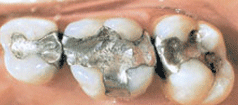Composite Resin Restorations

Depending on the area of decay or the size of the existing filling some teeth can be restored with bonded composite (plastic) resin filling.
Composite resin fillings are tooth colored so they look better, are durable and bond to the tooth structure so they provide a measure of support and strength for the restored tooth.
They are often smaller and more conservative than other filling materials because only the decayed portion needs to be eliminated. This helps to preserve the tooth structure for years to come.
If a patient's wish is for a longer lasting restoration or if the size of the fillings is greater than 40-50% of the biting surface of the tooth then a porcelain or gold inlay or onlay is recommended.
What are the advantages of composites?
Aesthetics are the main advantage, since dentists can blend shades to create a color nearly identical to that of the actual tooth. Composites bond to the tooth to support the remaining tooth structure, which helps to prevent breakage and insulate the tooth from excessive temperature changes.
What are the disadvantages?
Sometimes patient can experience post-operative sensitivity. Furthermore, the shade of the composite can change slightly if the patient drinks tea, coffee, or other staining foods. The dentist can put a clear plastic coating over the composite to prevent the color from changing if a patient is particularly concerned about tooth color.



